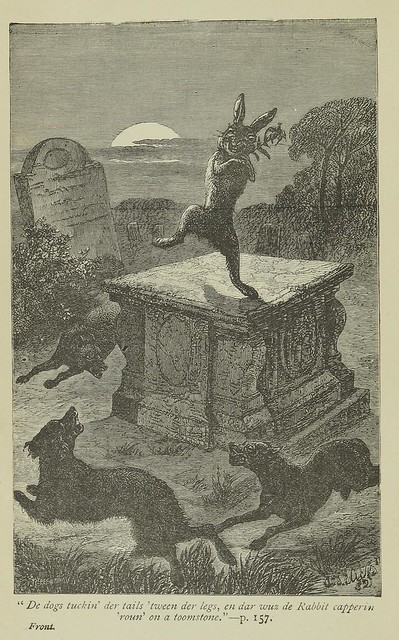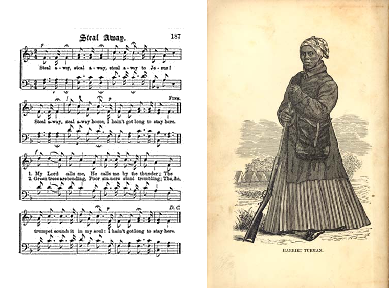Stories, Songs, and Survival: the role of narrative in slave religion
Posted on by smisu13p
Written by: Meena Al-Emleh.
[Adapted from an essay written for ANTH228/328: Anthropology of Religion and the Supernatural]

Preacher detail dhs spet. 1874 p. 463 congregation. Source: https://www.flickr.com/photos/jimsurkamp/33698015396/
African American culture has been described as a narrative culture[i]. Gospel churches in particular are examples of the strong cultural ties between storytelling and Black spiritual identity. This narrative tradition did not begin with the conversion of enslaved Africans to Christianity, however. Rather it was formed as Christian traditions were actively fused with deep-rooted narrative traditions from diverse African peoples.
If we examine how this took place, we can see that the religion that came to be practiced by slaves during the Antebellum period was characterised cultural adaptation. The narratives at the heart of this religion played a key role in negotiations of memory, pain, and fractured cultural identities and beliefs. They created conceptual spaces where community and autonomy could be asserted, and new identities developed.
So how exactly did stories achieve all of this?
Context and cultural change
The context from which ‘slave religion’ grew is complex – the term itself given by religious scholar Albert Raboteau to the varied Christian-adjacent religious practices among new-world slaves.
The first African slaves were brought to the ‘New World’ in the early 17th century. They were uprooted from their entire social worlds – moved around and sold without any regard for their tribal and linguistic relations, nor family ties. Slavery was a systematic eradication of culture, selfhood, and humanity, which in many ways constituted a “social death” for slaves[ii].
While much was lost in this process, plantation life did not fully erase slaves’ cultures. Instead many living traditions were carried with people into their new lives, and adapted to fit the new social and spiritual frameworks presented to them. Many slaves were from tribes in West and Central Africa, and as they lived and worked together, these shared beliefs and experiences developed into a “quasi-African worldview.”[iii]

Louis Armstrong Park, New Orleans. A plaque reads: “During the late 17th century and well into the 18th centuries. slaves gathered at Congo Square on Sundays and sang, danced, and drummed in authentic West Aftrican style. This rich legacy of African celebration is the foundation of New Orleans’ unique musical traditions, including Jazz.” Sculpture by Adewale S. Adenle, dedocated April, 2010. Photo October 9, 2014 (by Kent Kanouse).
On plantations in North America, slaves came into contact with Christian concepts and biblical stories, and many individuals and communities responded to these. Yet they were often excluded from the actual institution of Christianity by racist ideologies that held them as ‘soul-less’ and therefore exempt from salvation[iv]. Because of this, many of their own religious meetings were held in secret[v]. These were spaces where the complexities of slave life could be negotiated, and where new communal identities could begin to develop[vi].
Folktales and the forging of new identities
One key form of narrative for African slaves in the Antebellum era, was the folktale. Folk stories brought from Africa did not remain static, but changed alongside the tellers’ social contexts – an active negotiation of social life occurring in the telling.
Call-and-response was a prominent feature of oral storytelling – a style originating in West and Central Africa, and heavily encouraging group participation[vii]. Cortazzi believes that in typical oral narratives, the audience’s cultural positionality and beliefs are reinforced by the singular teller[viii]. As call-and-response is driven by the whole group rather than a single storyteller, it offers group-driven communal positioning. In this way the folklore functioned as a counter to the dislocation of slavery, as together slaves could develop new shared systems of understanding.

Uncle Remus, or, Mr. Fox, Mr. Rabbit, and Mr. Terrapin, 1891 (circa). Mr Fox is another example of a trickster character, in a moral tale. Source: https://www.flickr.com/photos/43021516@N06/20712823746/
Records of popular characters and scenarios in Antebellum era folk tales show an integration of Christian concepts into African stories. For example, the Devil portrayed in these tales bears a closer resemblance to the trickster of West African folklore than the explicitly evil Satan within Christianity[ix]. As is seen in the stories of ‘how Jack beat the Devil’ and ‘how John married the Devil’s daughter’, the Devil is a figure who makes deals for your soul through mischief, and who is ultimately beaten by a cultural hero with similar trickster qualities[x].
The main characters jump in and out of expected roles, according to the demands of the situation, deploying patterns of behaviour like shamming, silence, and masking to stay alive. This parallels the lived cultural reality of the enslaved people who participated in the telling. It also provides a narrative space for the formation of new identities and world views – distinct from either white Christian, or African identities, and yet more complex than a simple blend of the two.
The ‘Negro Spiritual’: songs of suffering and deliverance
Another narrative form that took shape within religious slave communities is that of the ‘spiritual’ – Christian songs created to emphasise particular Christian values and express the pain of slavery.
The traditions of musical speech and musical selfhood in this context is intrinsically African, as it draws from the tonal languages and antiphonal music of these slaves’ ancestors[xi]. Like stories they often used call-and-response styles to involve the whole group. The songs are thought to have emerged creatively between the musicality of the preacher and the “talk back” of the congregation[ii] – a specific mode of song-speech.
The spirituals also repositioned the communal narrative of these antebellum-era slaves, as a narrative of deliverance. They frequently supplanted the Old Testament story of the Children of Israel with their own narrative of captivity, positioning them within a long history of survival stretching back to Moses. The theme of deliverance and a focus on a hopeful future are key in the lyrics. For example the spiritual Didn’t My Lord Deliver Daniel? which says: “Didn’t my Lord deliver Daniel, an’ why not-a every man.”[xiii]

“Steal Away to Jesus” was a song allegedly used by Harriet Tubman (pictured) to announce to potential freedom seekers that she was going to lead people out of slavery. The drawing of Harriet Tubman courtesy of University of North Carolina at Chapel Hill. Source: http://www.actaonline.org/content/revolution-song-healing-through-negro-spirituals-glides-womens-center
Survival was central, but also resistance. Spirituals reminded people that survival depended on collective strength. They also became a messaging tool among emancipationist conspirators, who reworked the songs with new, secret references to escape routes, meeting times, and safe houses[ii].
This way of coding messages had close roots in folklore traditions – a technique frequently used by protagonists in trickster stories. In this way, spirituals acted as both a literal and figurative way to share and protect new African-American ways of being.
Conclusions on narrative, identity, and culture
Enslaved Africans in the Antebellum United States used narrative, in its many forms, to gradually unify memory, traditions, beliefs, and cultural changes into a communal identity. As such the narratives central to ‘slave religion’ became a way of protecting themselves against the spiritual violence enacted on them by the system of slavery – the loss of place, connectedness, and identity.
Cortazzi asserts that “Narrative […] is a discourse structure or genre which reflects culture.[viii]” However in this this context, narrative did more than that: it shaped the future of a people by reflecting not just what the culture was, but also what it needed to be.
References [i] Tolagbe Ogunleye, “African American Folklore: It’s Role in Reconstructing African American History.” Journal of Black Studies 27 no. 4 (1997), 16; Waldo F. Martin Jr., “The Sounds of Blackness” In Upon These Shores: Themes in the African-American Experience 1600 to the Present, ed. William Scott & William Shade (London: Routledge, 2013), 254. [ii] Luke Powery, Dry Dem Bones: Preaching, Death, and Hope (Minneapolis: Augsburg Fortress Publishers, 2012), 19-50; 23; 60 [iii] Steve Vaughn, “Making Jesus Black: The Historiographical Debate on the Roots of African-American Christianity.” Journal of Negro History 82 no.1 (1997), 28. [iv] Jon Sensbach, “Slaves to Intolerance: African American Christianity and Religious Freedom in Early America” In The First Prejudice: Religious Tolerance and Intolerance in Early America, ed. Chris Beneke & Christopher Grenda (Philadelphia: University of Pennsylvania Press, 2011), 204. [v] Charles Orser, “The Archaeology of African-American Slave Religion in the Antebellum South” In Southern Crossroads: Perspectives on Religion and Culture, ed. Walter Conser & Rodger Payne (Lexington: University of Kentucky Press, 2008), 45. [vi] Edward Pavlic, Crossroads Modernism: Descent and Emergence in African-American Literary Culture (Minneapolis: University of Minnesota Press, 2002), 7-8. [vii] Wallace D. Best, Passionately Human, No Less Divine: Religion and Culture in Black Chicago, 1915-1952 (Princeton, N.J.: Princeton University Press, 2005), 98. [viii] Martin Cortazzi, Narrative Analysis (London: Routledge, 2014), 167-193; 168. [ix] David Murray, Matter, Magic, and Spirit: Representing Indian and African American Belief (Philadelphia: University of Pennsylvania Press, 2007), 58. [x] Zora Neale Hurston, Mules and Men (New York: Harper Collins, 2009). [xi] Albert Raboteau, Slave Religion: the Invisible Institution (Oxford: Oxford University Press, 2004), 52. [xiii] David Spener, We Shall Not Be Moved: Biography of Song and Struggle (Philadelphia: Temple University Press, 2016), 33.
Posted in Case study, Undergrad coursework | Tagged African-American, Antebellum, anthropology, Christianity, culture, faith, identity, Narrative, plantation, religion, Slaves, solidarity, songs, spirituality, stories, United States | Leave a reply

